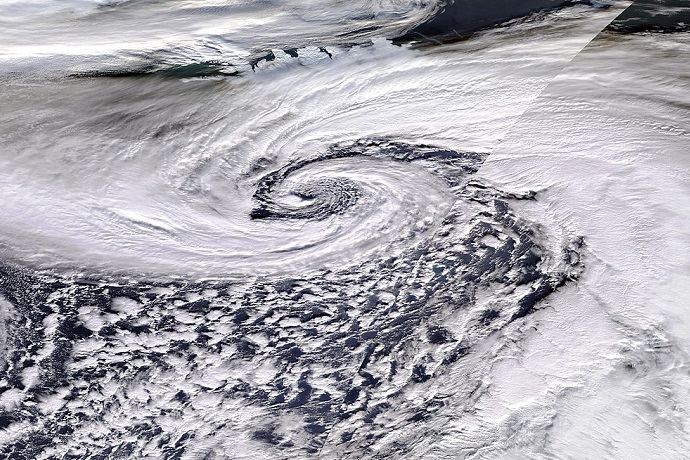

The database includes forecasts of severe weather, such as Storm Dennis, shown here over the North Atlantic on 15 February 2020. (Image: NASA)
The TIGGE database of global medium-range ensemble forecasts hosted by ECMWF holds a growing range of data from 11 forecasting centres readily available to researchers worldwide.
The Australian Bureau of Meteorology (BoM) rejoined TIGGE recently, and the German national meteorological service (DWD) is set to add its global ensemble forecasts later this year.
TIGGE was set up by the WMO’s World Weather Research Programme in 2006. The operational forecasts it contains are available to researchers just two days after production.
Possible uses include research on ensemble forecasting, predictability and the development of products to improve the prediction of severe weather.
Use case: Storm Dennis
An ensemble forecast is a set of forecasts that represent the range of future weather possibilities.
Multiple simulations are run, each with slightly different initial conditions and slightly perturbed weather models, reflecting the inevitable uncertainty in these aspects. The spread between the simulations then gives an indication of the uncertainty associated with the forecast.
“One of the uses of TIGGE is to explore how different centres handle uncertainty in their ensemble forecasts,” says ECMWF scientist Mark Rodwell. He gives the example of Storm Dennis, one of the most intense extratropical cyclones ever seen over the North Atlantic.
The shading in the plots below shows the growth rate in uncertainty in 6 to 18-hour forecasts as Storm Dennis intensified over the North Atlantic on 13 February 2020.

The charts show the ensemble forecast spread growth rate (shading) in 6 to 18-hour forecasts for 18 UTC on 13 February 2020 from ECMWF, the UK Met Office, the Japan Meteorological Agency (JMA), and the Australian Bureau of Meteorology (BoM). The dots indicate areas of precipitation, the arrows show winds at 850 hPa, and the contours show geopotential height at 250 hPa.
These forecasts from four different centres are all available in TIGGE.
“They broadly agree on predicted winds and precipitation, but they disagree on the rate of growth in uncertainty prior to making landfall over western Europe,” says Mark.
“Scientists can use the data to explore the roles of initial and model perturbations in determining the evolution of forecast spread, and thus of forecast uncertainty.”
A growing database
TIGGE currently includes forecasts from the following forecasting centres:
|
Forecasting centre |
Time range |
|
Australian Bureau of Meteorology (BoM) |
10 days |
|
China Meteorological Administration (CMA) |
15 days |
|
Brazil’s Centre for Weather Forecasting and Climate Studies (CPTEC) |
15 days |
|
Environment and Climate Change Canada (ECCC) |
16 days |
|
ECMWF |
15 days |
|
Japan Meteorological Agency (JMA) |
11 days |
|
Korea Meteorological Administration (KMA) |
10 days |
|
Météo-France |
72 hours/108 hours |
|
US National Centers for Environmental Prediction (NCEP) |
16 days |
|
India’s National Centre for Medium Range Weather Forecasting (NCMRWF) |
10 days |
|
UK Met Office |
174 hours |
“The data comprise 6-hourly model output for a range of parameters, including surface and other single-level fields, and some multi-level fields,” says Richard Mladek, who maintains the TIGGE database.
The total TIGGE data volume has reached about 3.5 petabytes. Users come from China, the US, the United Kingdom, India, Japan, France, Germany and many more countries across the world.
“In a typical month, users retrieve more than 200 terabytes of TIGGE data from ECMWF’s Meteorological Archival and Retrieval System (MARS),” Richard says, “but the volume of data delivered after post-processing is substantially smaller.”

The chart shows the volume of TIGGE data retrieved from MARS before post-processing and the volume of TIGGE data delivered to users after post-processing.
Further information
More information on the database, including details on how to access the data, is available on ECMWF’s TIGGE web page.
